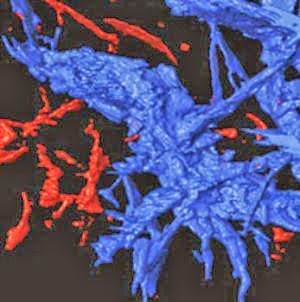
Stanford scientists recreated the intense pressures and temperatures found deep within Earth, resulting in a discovery that complicates theories of how the planet and its core were formed.
The same process that allows water to trickle through coffee grinds to create your morning espresso may have played a key role in the formation of the early Earth and influenced its internal organization, according to a new study by scientists at Stanford’s School of Earth Sciences.
The finding, published in the current issue of the journal Nature Geoscience, lends credence to a theory first proposed nearly half a century ago suggesting that Earth’s iron-rich core and layered internal structure might have formed in a series of steps that took place over millions of years under varying temperature and pressure conditions.
“We know that Earth today has a core and a mantle that are differentiated. With improving technology, we can look at different mechanisms of how this came to be in a new light,” said study leader Wendy Mao, an assistant professor of geological and environmental sciences at Stanford, and of photon sciences at the SLAC National Accelerator Laboratory, which is operated by the university.
Earth’s innards are presently divided into layers, with the rocky mantle composed mostly of silicates overlying an iron-rich metallic core. How the planet came to have this orderly arrangement is a major mystery, especially since scientists think its beginnings were messy and chaotic, the result of small bodies made up of rock and metals crashing and clumping together shortly after the formation of the sun and the birth of the solar system some 4.5 billion years ago.
How did Earth evolve from this conglomerated mass of rocks and metals into its current layered state?
Separating metal from rock
One idea is that the heat generated by the collisions and by the radioactive decay of certain isotopes warmed Earth. The planet could have gotten so hot that its rocks and metals melted. The molten rocks and metals in this “magma ocean” would then have separated into distinct layers as a result of their different densities. Iron would have drifted downward towards the planet’s center, while silicates remained on top.
Other scientists have proposed that even if the early Earth’s temperature was not hot enough to melt silicates, the molten iron might still have separated out by percolating through the solid silicate layer.
The thought was that pockets of molten iron trapped in the mantle layer could tunnel through the surrounding rock to create channels, or capillaries. This network of tunnels could have helped funnel molten iron towards the planet’s center to join the spherical metallic heart that was slowly amassing there.
However, this “percolation” theory was dealt a major blow when scientists discovered that, in the upper mantle layer at least, the molten iron tended to form isolated spheres that didn’t interact with one another, similar to the way water beads up on a waxed surface.
For this reason, scientists had previously thought that percolation couldn’t be possible, Mao said.
Recreating ancient Earth
But a new experiment conducted by Mao and her team uncovered fresh evidence that percolation might still be a viable mechanism for explaining the formation of Earth’s core.
Working with researchers at the U.S. Department of Energy’s SLAC facility, Mao and her team recreated a speck of the molten silicate and iron material that scientists believe existed deep inside the early Earth.
To do this, Mao’s team placed minute amounts of iron and silicate rock into a metal chamber that they then inserted between the tips of two small diamonds. Squeezing these “diamond anvils” together recreated the immense pressures present in Earth’s interior, and a laser beam was used to heat the sample to a high enough temperature to melt the iron.
After the sample cooled, the scientists examined it using X-ray-computed tomography. Tomography creates a three-dimensional image of an object by combining a series of two-dimensional slices. A computer program then helps flesh out the re-creation of the object.
A state-of-the-art X-ray microscope at SLAC allowed Mao’s team to resolve nanometer-scale details in their sample of heated silicates and iron. The higher resolution allowed the scientists to observe never-before-seen changes in the texture and shape of the molten iron and silicates as they responded to the same intense pressures and temperatures that were present deep in the early Earth.
Which happened first?
The experiment confirmed the findings from previous studies that molten iron in the upper mantle tended to form isolated blobs, which would have prevented percolation from happening. “In order for percolation to be efficient, the molten iron needs to be able to form continuous channels through the solid,” Mao explained.
However, the scientists found that at the higher pressures and temperatures that would have been present in the early Earth’s lower mantle, the structure of the silicates changed in a way that permitted connections to form between pockets of molten iron, making percolation possible.
“Scientists had said this theory wasn’t possible, but now we’re saying, under certain conditions that we know exist in the planet, it could happen,” Mao said. “So this brings back another possibility for how the core might have formed.”
The team’s new findings do not rule out the possibility that differentiation began when Earth was in a magma ocean state. In fact, both mechanisms could have occurred, said study first author Crystal Shi, a graduate student in Mao’s lab.
“We don’t know which mechanism happened first, or if the two happened together,” Shi said. “At the very beginning, Earth would have still been very hot, and the magma ocean mechanism could have been important. But later as the planet cooled, percolation may have become the dominant mechanism.”
Scientists from China’s Center for High Pressure Science and Technology Advanced Research, and the Carnegie Institution of Washington also contributed to this research.










